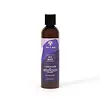What's inside
What's inside
 Key Ingredients
Key Ingredients

 Benefits
Benefits

 Concerns
Concerns

 Ingredients Side-by-side
Ingredients Side-by-side

Water
Skin ConditioningGlycerin
HumectantBetaine
HumectantCetearyl Alcohol
EmollientCetyl Alcohol
EmollientLinum Usitatissimum Seed Extract
PerfumingBrassicamidopropyl Dimethylamine
Skin ConditioningPolyglyceryl-3 Betainate Acetate
Oryza Sativa Extract
AbsorbentBiotin
AntiseborrhoeicCeramide NP
Skin ConditioningPhytosterols
Skin ConditioningInositol
HumectantCopper Tripeptide-1
Skin ConditioningSerenoa Serrulata Fruit Extract
Skin ConditioningCocos Nucifera Oil
MaskingCetyl Esters
EmollientC12-15 Alkyl Lactate
EmollientLactic Acid
BufferingLauramidopropyl Hydroxysultaine
CleansingCaprylhydroxamic Acid
Sodium Chloride
MaskingCaprylyl Glycol
EmollientPotassium Sorbate
PreservativeSodium Benzoate
MaskingWater, Glycerin, Betaine, Cetearyl Alcohol, Cetyl Alcohol, Linum Usitatissimum Seed Extract, Brassicamidopropyl Dimethylamine, Polyglyceryl-3 Betainate Acetate, Oryza Sativa Extract, Biotin, Ceramide NP, Phytosterols, Inositol, Copper Tripeptide-1, Serenoa Serrulata Fruit Extract, Cocos Nucifera Oil, Cetyl Esters, C12-15 Alkyl Lactate, Lactic Acid, Lauramidopropyl Hydroxysultaine, Caprylhydroxamic Acid, Sodium Chloride, Caprylyl Glycol, Potassium Sorbate, Sodium Benzoate
Water
Skin ConditioningSodium C16 Olefin Sulfonate
EmulsifyingCocamidopropyl Betaine
CleansingGlycol Stearate
EmollientCocamide Mea
EmulsifyingPolyquaternium-10
Camellia Sinensis Leaf Extract
AntimicrobialEucalyptus Globulus Leaf Oil
PerfumingMentha Piperita Oil
MaskingSalvia Officinalis Oil
MaskingGlycerin
HumectantRosmarinus Officinalis Stem Oil
PerfumingTocopherol
AntioxidantHelianthus Annuus Seed Oil
EmollientAloe Barbadensis Leaf Juice
Skin ConditioningMelaleuca Alternifolia Leaf Oil
AntioxidantPhenoxyethanol
PreservativeHydroxyethylcellulose
Emulsion StabilisingParfum
MaskingSodium Chloride
MaskingMenthol
MaskingEthylhexylglycerin
Skin ConditioningEthanolamine
BufferingCitric Acid
BufferingBenzyl Benzoate
AntimicrobialWater, Sodium C16 Olefin Sulfonate, Cocamidopropyl Betaine, Glycol Stearate, Cocamide Mea, Polyquaternium-10, Camellia Sinensis Leaf Extract, Eucalyptus Globulus Leaf Oil, Mentha Piperita Oil, Salvia Officinalis Oil, Glycerin, Rosmarinus Officinalis Stem Oil, Tocopherol, Helianthus Annuus Seed Oil, Aloe Barbadensis Leaf Juice, Melaleuca Alternifolia Leaf Oil, Phenoxyethanol, Hydroxyethylcellulose, Parfum, Sodium Chloride, Menthol, Ethylhexylglycerin, Ethanolamine, Citric Acid, Benzyl Benzoate
Ingredients Explained
These ingredients are found in both products.
Ingredients higher up in an ingredient list are typically present in a larger amount.
Glycerin is already naturally found in your skin. It helps moisturize and protect your skin.
A study from 2016 found glycerin to be more effective as a humectant than AHAs and hyaluronic acid.
As a humectant, it helps the skin stay hydrated by pulling moisture to your skin. The low molecular weight of glycerin allows it to pull moisture into the deeper layers of your skin.
Hydrated skin improves your skin barrier; Your skin barrier helps protect against irritants and bacteria.
Glycerin has also been found to have antimicrobial and antiviral properties. Due to these properties, glycerin is often used in wound and burn treatments.
In cosmetics, glycerin is usually derived from plants such as soybean or palm. However, it can also be sourced from animals, such as tallow or animal fat.
This ingredient is organic, colorless, odorless, and non-toxic.
Glycerin is the name for this ingredient in American English. British English uses Glycerol/Glycerine.
Learn more about GlycerinChances are, you eat sodium chloride every day. Sodium Chloride is also known as table salt.
This ingredient has many purposes in skincare: thickener, emulsifier, and exfoliator.
You'll most likely find this ingredient in cleansers where it is used to create a gel-like texture. As an emulsifier, it also prevents ingredients from separating.
There is much debate on whether this ingredient is comedogenic. The short answer - comedogenic ratings don't tell the whole story. Learn more about comegodenic ratings here.
The concensus about this ingredient causing acne seems to be divided. Research is needed to understand if this ingredient does cause acne.
Scrubs may use salt as the primary exfoliating ingredient.
Learn more about Sodium ChlorideWater. It's the most common cosmetic ingredient of all. You'll usually see it at the top of ingredient lists, meaning that it makes up the largest part of the product.
So why is it so popular? Water most often acts as a solvent - this means that it helps dissolve other ingredients into the formulation.
You'll also recognize water as that liquid we all need to stay alive. If you see this, drink a glass of water. Stay hydrated!
Learn more about Water